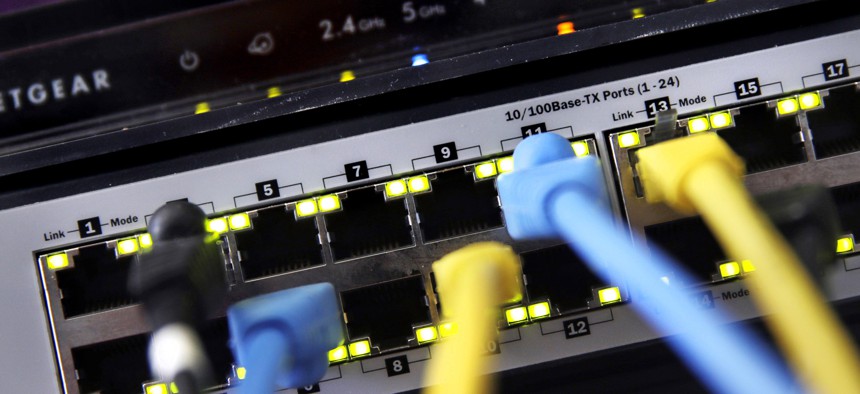States Can Craft Own Net Neutrality Rules, Appeals Court Rules

In this June 19, 2018, file photo a router and internet switch are displayed in East Derry, N.H. AP Photo/Charles Krupa
A federal appeals court upheld much of the FCC’s rollback of net neutrality rules but found that the commission overstepped its authority when it blocked states from enacting their own internet regulations.
The Federal Communications Commission exceeded its authority when it sought to block states from adopting their own net neutrality laws, a federal appeals court ruled Tuesday.
The ruling, from the U.S. Court of Appeals for the D.C. Circuit, paves the way for states to pursue their own net neutrality policies but otherwise largely upheld the FCC’s rollback of Obama-era internet regulations.
The D.C. Circuit found that the FCC “lacked the legal authority to categorically abolish all fifty states’ statutorily conferred authority to regulate intrastate communications.”
The Obama administration’s 2015 net neutrality rules had prohibited internet providers from blocking or slowing down access to certain websites or charging third parties to speed up access for their websites or content.
Arguing that the rules would chill innovation in broadband, the Trump administration in 2017 rolled back those policies and issued a preemption directive that sought to block states from adopting laws that conflicted with the FCC’s ruling.
But as the Trump administration moved, so did states. At least nine states have implemented some form of protection for net neutrality, according to the National Regulatory Research Institute. That includes California, which after adopting the strictest net neutrality law in the nation in 2018 later agreed not to enforce the law pending an outcome in this court case. Many more tried but failed to pass similar protections.
On Tuesday, FCC officials suggested that the court decision doesn’t settle the issue, saying state-level net neutrality laws may continue to play out in the courts.
A senior FCC official, who spoke anonymously on background to reporters, said the ruling does not give states “the green light” to enact or enforce their own net neutrality laws. The official said the FCC is still evaluating the ruling to determine next steps, but pointed out a passage in the decision which indicates the FCC could potentially fight state laws on a case-by-case basis.
“If the Commission can explain how a state practice actually undermines the 2018 Order, then it can invoke conflict preemption,” the ruling states. “If it cannot make that showing, then presumably the two regulations can co-exist as the Federal Communications Act envisions.”
FCC Commissioner Ajit Pai has previously argued against allowing states to adopt their own standards, saying that a patchwork of state laws “harms investment and innovation in advanced communications services.”
He called Tuesday’s ruling, which largely upheld the FCC’s rollback, a “victory for consumers, broadband deployment, and the free and open Internet.”
Consumer advocacy groups, however, also saw the ruling as a win for states.
“The court's decision underscores and clarifies that when the FCC abdicates its responsibility to protect net neutrality, states can fill the void,” said Katharine Trendacosta, manager of policy of activism at the Electronic Frontier Foundation. “California has already taken the lead, passing a gold standard net neutrality state-level bill. Other states can and should follow suit.”
California Attorney General Xavier Beccera said the decision “blocks the FCC's effort to preempt state net neutrality laws through regulation.”
The ruling also remanded other portions of the net neutrality regulations and ordered the FCC to address issues related to public safety, telecom companies’ access to utility pole, and the Lifeline Program, which provides subsidies for low-income consumers.
The senior FCC official declined to speculate on whether the commission will appeal the ruling. The commission could potentially appeal the case for rehearing by the full D.C. Circuit or to the U.S. Supreme Court.
Andrea Noble is a staff correspondent with Route Fifty.
NEXT STORY: How CX programs benefit more than the customer





